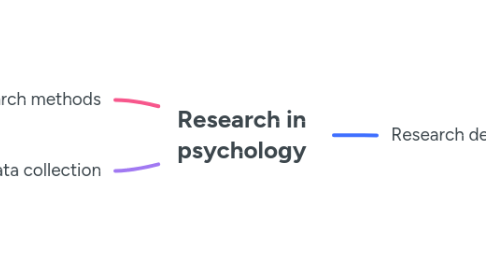
1. Research methods
1.1. Longitudinal study
1.1.1. study developmental changes by evaluating a sample at different ages of their lives, over a period of time
1.1.2. Pros
1.1.2.1. In-depth and high amounts of data
1.1.3. Cons
1.1.3.1. Results can take years, high drop out rate
1.2. Cross-sectional study
1.2.1. study developmental changes by comparing a sample who are the of different ages, at that point in time
1.2.2. Pros
1.2.2.1. Fast results, low drop out rate
1.2.3. Cons
1.2.3.1. Internal validity (eg individuals who are more advanced than others), cohort effects (eg that particular cohort mave all experienced more advanced teaching than other cohorts of that age)
2. Data collection
2.1. See 1.5 - Qualitative vs Quantitative Data
2.2. See 1.5 - Choosing Best Collection Method
3. Research designs
3.1. Correlational research
3.1.1. Discover relationships among variables
3.1.1.1. Anything than can be measured eg behaviours, attitudes etc, is a potential valiable
3.1.1.1.1. All participants provide scores on the same two variables
3.1.1.1.2. eg. association between shyness + no. of FB friends; between age + conservatism; between time spent on social media and grades in school etc
3.1.1.2. Pros
3.1.1.2.1. Less expensive; time-limited; less equipment required
3.1.1.2.2. Study natural behaviour
3.1.1.2.3. Make predictions
3.1.1.2.4. Suggest avenues for further research
3.1.1.3. Cons
3.1.1.3.1. Cannot know about what variable causes what, only that one variable is associated to the other
3.1.1.4. Pearson correlation coefficient (r)
3.1.1.4.1. Values range from -1.0 to 1.0
3.1.1.4.2. Does not tell anything about one individual's score
3.1.1.5. Scatter-plot
3.1.1.5.1. Most popular way of graphing the raw data values of each of the measured variables
3.1.1.6. Third variable
3.1.1.6.1. Not part of the research hypothesis but is the cause of the variables and their correlation
3.1.1.7. Discussing results
3.1.1.7.1. Designate the variables X and Y
3.2. Experimental research
3.2.1. Assess cause and effect
3.2.1.1. Placebo
3.2.1.1.1. Variable which looks like/is told to be the real medication but is actually chemically inert
3.2.1.2. Independent variable
3.2.1.2.1. Manipulated by the researcher
3.2.1.2.2. (What you're changing)
3.2.1.3. Dependent variable
3.2.1.3.1. Score which is dependent on the actions of the independent variable
3.2.1.3.2. (What you're measuring)
3.2.1.4. Control
3.2.1.4.1. Sample that does not recieve any treatment
3.2.1.4.2. Allows comparison of manipulated condition with the placebo
3.2.1.5. Samples must be demographically equivalent and large enough to appropriately represent the population of interest
3.2.1.6. Confound
3.2.1.6.1. Unwanted variable in the research which has potentially caused the results; instead of the independent variable
3.2.1.7. Quasi-experimental research
3.2.1.7.1. As a large number of human characteristics cannot be manipulated or assigned, disallowing for random assignment of participants to sample groups
3.2.2. Allows a very high degree of control over who does what, and even the most miniscule results
3.2.3. Laboratory setting may not result in authentic behaviour from sample
3.2.4. A large proportion of psychology research is not experimental for a variety of practical and ethical reasons
3.3. Descriptive research
3.3.1. Provides a snapshot of the current state of affairs - thoughts, feelings and/or behaviour of the individual
3.3.1.1. Case studies
3.3.1.1.1. Descriptive records of an individual's or a single small group's experiences and behaviour
3.3.1.2. Surveys and tests
3.3.1.2.1. Surveys
3.3.1.2.2. Psychological tests
3.3.1.3. Naturalistic observation
3.3.1.3.1. Observation of everyday events
3.3.1.4. Laboratory observation
3.3.1.4.1. Pros
3.3.1.4.2. Cons
